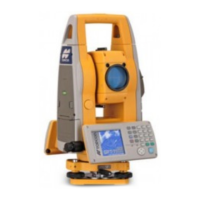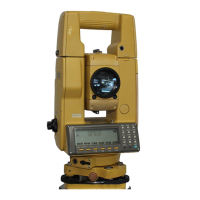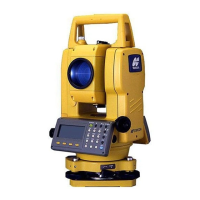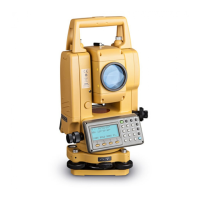
Do you have a question about the Topcon GTS-750 Series and is the answer not in the manual?
| Distance Measurement | Yes |
|---|---|
| Telescope Magnification | 30x |
| Compensator | Dual-axis |
| Operating Temperature Range | -20°C to +50°C |
| Type | Total Station |
| Distance Measurement Range (with prism) | 3, 000 meters |
| Distance Measurement Range (without prism) | 400 m |
| Data Storage | Internal memory |
| Communication | Bluetooth |
| Display | LCD |
| Battery Life | 10 hours |
| Distance Measurement Accuracy | ±(2 mm + 2 ppm) |
Guidelines for safe operation and handling of the instrument.
Explains warning symbols and provides critical safety warnings.
Outlines user obligations and manufacturer disclaimers.
Details safe practices for using the laser pointer and distance measurement.
Identifies physical parts of the instrument.
Describes the main menu, measurement screen, marks, and keys.
Explains how to adjust screen brightness and key illumination.
Details manual and automatic data backup processes.
Covers instrument reset and sensor function for operation.
Guides on calibrating the touch screen for proper response.
Explains operation keys and how to manage the touch panel.
Details the correct method for shutting down the instrument.
Describes the dynamic functions assigned to soft keys.
Explains options accessible via the Star Key.
Covers automatic power saving features.
Explains data transfer via USB.
Details connecting external or onboard batteries.
Guides on mounting, leveling, and centering the instrument.
Covers the procedure for turning on the instrument.
Shows how to interpret the battery status indicator.
Explains automatic tilt compensation for accurate angle readings.
Covers internal error compensation for precise measurements.
Details methods for inputting data via keyboard or screen.
Guides on inserting and extracting CF memory cards.
Explains setting up PC connection for data transfer.
Covers measuring horizontal and vertical angles and display modes.
Details prism, non-prism, and tracking distance measurement modes.
Explains setting occupied points and executing coordinate measurements.
Describes transferring measurement results to a data collector.
Program for setting direction angle using coordinates.
Program for measuring vertical distance to remote objects.
Program for calculating distances between points.
Program for measuring angles multiple times for accuracy.
Details options for measurement, communication, input, and units.
Provides an example of setting audio tone parameters.
Covers verifying and setting instrument constants for accuracy.
Explains procedures to check optical axes of EDM, theodolite, and laser.
Details checks and adjustments for plate level, circular level, cross-hair, etc.
Step-by-step guide to inputting instrument constants.
Covers adjustment and display of systematic error compensation.
Guides on setting prism constants for accurate measurements.
Explains the formulas for atmospheric correction.
Details setting temperature and pressure values for correction.
Presents formulas for distance calculation with corrections.
Covers battery removal, charging, and installation.
Lists system messages and their meanings.
Lists error codes and recommended countermeasures.
Details the theory and application of dual axis compensation.











